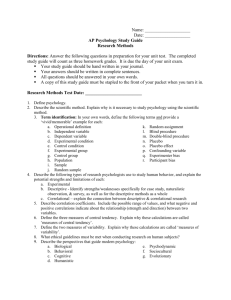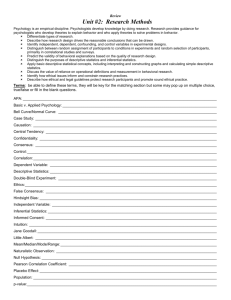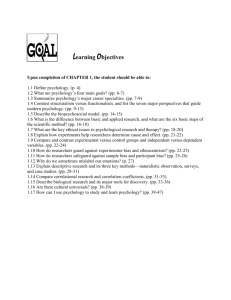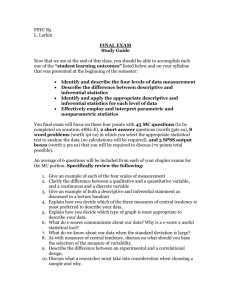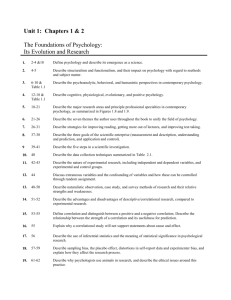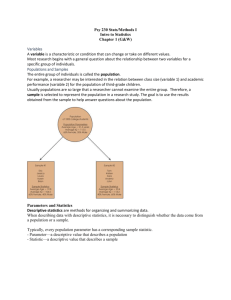AP Psych – Ch 2 – Research Methods
advertisement
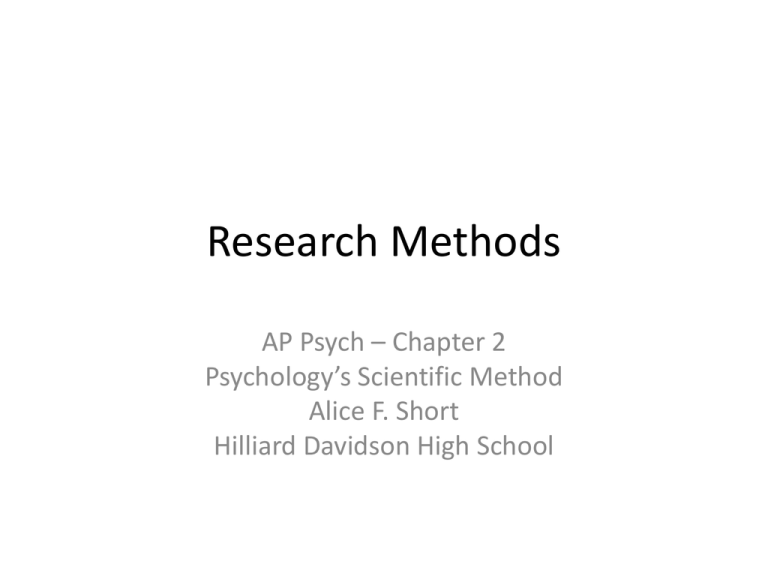
Research Methods AP Psych – Chapter 2 Psychology’s Scientific Method Alice F. Short Hilliard Davidson High School Psychology Majors • 2 Most Commonly Required Classes: – Research – Statistics A SHORT Time to Ponder Why would these be the two most required classes for psychology majors across the country? Chapter Preview • • • • • • • Psychology’s Scientific Method Types of Psychological Research Research Samples and Settings Analyzing and Interpreting Data Conducting Ethical Research Thinking Critically About Research Scientific Method and Health and Wellness A SHORT Time to Ponder • As a society, do we value critical thinking? • Is critical thinking uncomfortable sometimes? Scientific Method • Science is a method. • (It’s a VERB) • It’s not what you study, but how you study it. – any objective person can use the scientific method 1. 2. 3. 4. 5. observe some phenomenon formulate hypothesis and predictions test through empirical research draw conclusions evaluate the theory Scientific Method – 1. Observe • Step 1: Observe some phenomenon – curiosity – variables – theory Scientific Method – 2. Hypothesize • Step 2: Formulate hypotheses and predictions – testable prediction – derived from theory Scientific Method – 3. Research • Step 3: Test through empirical research – operational definition of variables – analyze data using statistical procedures Scientific Method – 4. Conclusions • Step 4: Draw conclusions – replication of results → reliability – If other people cannot replicate your study, then your result are unreliable. – What could this potentially mean for your study? (Think critically!) Scientific Method – 5. Evaluate • Step 5: Evaluate the theory – change the theory? – peer review and publication • publish or perish – meta-analysis – method by which researchers combine results across studies to establish the strength of an effect – theory = broad umbrella category which can either be supported or refuted by testable hypotheses Descriptive Research • Goal: Describing a phenomenon – observation – surveys and interviews – case studies • Descriptive research does not answer questions about how and why things are the way they are Correlational Research • Goal: Identify relationships (does not mean there is a causal relationships) – correlation coefficient: r • -1.00 ≤ r ≤ 1.00 – strength of relationship: magnitude – direction of relationship: + / - Correlational Coefficients Scatter Plots Correlational Research • Positive Correlations – factors vary in same direction – ↑ and ↑ … or … ↓ and ↓ • Negative Correlations – factors vary in opposite direction – ↑ and ↓ … or … ↑ and ↓ Correlation and Causation • correlation does not equal causation • third variable problem – Why would some people not WANT to consider a third variable problem? • longitudinal design Experimental Research • Goal: Determine causation – random assignment – extremely important in experimental design – independent variable(s) – manipulation – dependent variable(s) – measurement • All of these vocabulary terms are very important to KNOW! Experimental Research • Experimental Group – independent variable is manipulated • Control Group – treated equally, except no manipulation of independent variable Validity • External Validity – representative of real world issues? – do results generalize to the real world? • Internal Validity – are dependent variable changes the result of independent variable manipulation? – bias? logical errors? Bias and Expectations • • • • • experimenter bias demand characteristics research participant bias placebo effect double-blind experiment Example of Experimental Research: Self Esteem • Baumeister’s research findings: – “high self esteem leads to aggression” • Donnellan & Trzesniewski’s research findings: – “low self esteem leads to aggression” • What accounts for these different findings? – lab-only aggression? – type of self esteem? Applying Different Research Methods to the Same Phenomenon • Example: Election of President Barack Obama • Possible Research Methods: – – – – – observation survey and interview case studies correlational research experimental research Research Sample • Population – entire group about whom conclusion drawn • Sample – portion of population actually observed • Representative Sample – characteristics similar to population – opposite of “biased sample” • Random Sample – equal chance of being selected Research Settings • “Artificial” world – laboratory setting – controlled setting • Real world - natural setting – naturalistic observation • DISCUSSION: What are the advantages and disadvantages of each setting? Analyzing and Interpreting Data • Statistics – mathematical methods used to report data • Descriptive Statistics – describe and summarize data – Measures of Central Tendency • mean • median • mode – Measures of Dispersion • range • standard deviation • Inferential Statistics – – – – – draw conclusions about data does data confirm the hypothesis? statistical significance α = 0.05 (confidence level) bridge between sample and population A SHORT Time to Ponder • What is the difference between descriptive statistics and inferential statistics? Research Ethics • research participants have rights • Institutional Review Board (IRB) • APA Guidelines – – – – informed consent confidentiality debriefing deception Animal Research in Psychology • • • • animal research has benefited humans used by 5% of researchers rats and mice used 90% of time standards of care in animal research – housing – feeding – psychological and physical well being Reality TV – Ethical Issues? • • • • informed consent? Deception? psychological and/or physical risk? is the behavior real? • DISCUSSION: What do YOU think? A Wise Consumer… is skeptical yet open-minded! • Cautions – exercise caution in applying group trends to individual experience – avoid overgeneralizing results – look for converging evidence – question causal inferences – consider the source Expressive Writing and Health • Results of study on suicide v. accidental death – different survivor health – different survivor rate of talking about the loss • Results lead to study on writing – those assigned to write about a trauma experienced better physical health Chapter Summary • Explain what makes psychology a science. • Discuss common research settings and the main types of research that are used in psychology. • Distinguish between descriptive statistics and inferential statistics. • Discuss some challenges that involve ethics, bias, and information. • Discuss scientific studies on the effect of writing about ones trauma. Chapter Summary • Steps of the Scientific Method 1. 2. 3. 4. 5. observe hypothesize research conclude evaluate • Research Methods and Settings – descriptive, correlational, and experimental studies conducted in natural settings or the lab Chapter Summary • Data Analysis and Interpretation – descriptive and inferential statistics • Challenges: Research Ethics and Bias – APA guidelines and the IRB • Expressive Writing and Health and Wellness – benefits of writing about trauma

